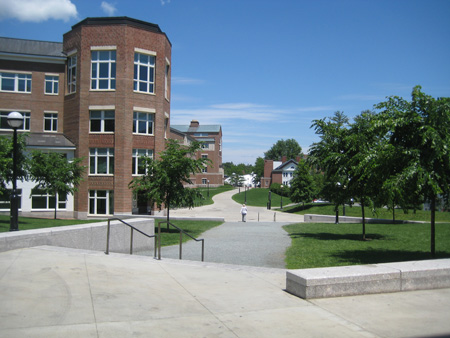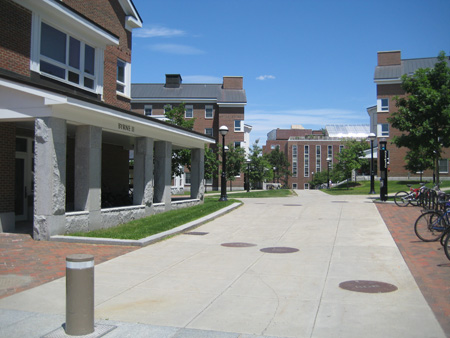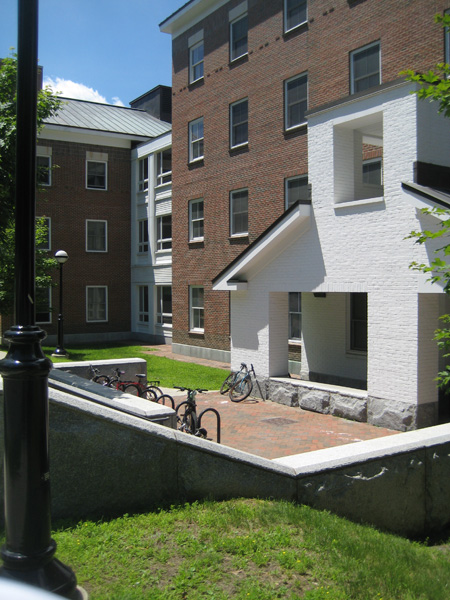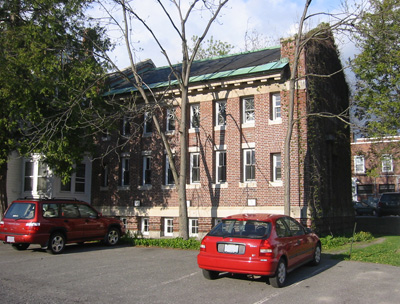-
An article in The Dartmouth notes the completion of work on Reed and Baker and the start of work on Dartmouth Hall.
-
The HGA [architects] page for the CECS building has an image showing main entrance with the name KEMENY HARDENBERG above the door.
-
The Goody Clancy page on the Irving Institute is up.
-
What might have been: The central and right-hand groups of images on Samer Afifi’s site show (1) a more traditionally-massed CECS on the site where it is now being built and (2) a very unfortunately sited Irving Institute way back on the River Cluster site — not only distant from any important campus axis but also blocking any further Tuck School expansion.
-
This has been noted here before, but it is always fun to see: A Kliment/Halsband-designed addition to the Shower Towers to house Sudikoff. It looks perfectly pleasant, but it must have been overtaken by VSBA planning for Berry Row.
-
Kellogg Auditorium, perhaps the only building at Dartmouth named for a room, has been renamed Kellogg Hall and renovated as a classroom building. It opened last fall (Susan Green, “Newly Renovated and Renamed Kellogg Hall Opens” (29 September 2020)).
-
Dartmouth News has a piece on the importance of the DHMC parking lot as a social space in pandemic times.
-
Many outlets, including the Concord Monitor, have written about the huge college-affiliated apartment complex that will be built on Route 120 at Mt. Support Road.
-
The Davison Block, a prominent and historic commercial building at the top of Main Street in downtown Hanover, has been sold by the Davison family, reports the Valley News.
-
The Valley News also had an article on a sort of Christkindlmarkt that was set up in Hanover over the holidays. Fantastic. So many nice touches could be added to downtown, especially on South Main Street above Lebanon Street, whether by raising the street level (happening?), adding bollards, or limiting traffic and parking. An inviting town square could be delineated in front of the Municipal Building.
-
The Valley News reports on the college’s pullback from the idea of a new biomass heating plant. This is probably good news for the preservation of the old smokestack.
-
There are some great photos in the annual roundup of shots by Dartmouth photographers. The aerial of Baker Lawn does look like a De Stijl painting, as noted. It might look even more like a work in batik, an impression created by the imperfections in the edges of the paths and the snow-covered roofs.
Category Archives: Berry Row
The master plan: initial impressions
See the latest version of Planning for Possibilities on the Presentations and Outcomes page. So far, the October 2020 draft plan and a slide deck have been posted.
The new master plan is very impressive.
The scope of the plan is impressive. It is the first master plan for the college to at least account for all college properties (the map on page 5 is zoomed out so far that it shows part of Canada) and the first plan to frame the campus in a regional context. Especially where transit is concerned, the Organic Farm and DHMC really do need to appear on the same map.
The document is more readable and less technical than its predecessors. Its creators made the interesting decision to use oblique aerial views exclusively — meaning that none of the proposals for development appear as flat “plans.”
The potential projects on campus look excellent. Placing a building on the lawn of Shabazz Hall makes so much sense. The natural site for a new physical sciences building beyond Burke of course requires yet another demolition of Dragon. The proposals for Bartlett and Wheeler additions are fantastic, with the latter being particularly bold. The natural row behind Mass Row could incorporate an abutment of, or at least an entry plaza for, the Cemetery Bridge at its south end. The Bema pavilion makes sense (maybe the place will see more use if it has a proper covered stage?), though erecting a frame building would be unusual in that space.
One might wish the planners had considered building on the vacant lots in front of Sanborn and south of Blunt as well. And why not show a building site on Berry Row between Kemeny and Moore? It has always been planned that way, even going back to VSBA days after the purchase of the hospital property. Oh well. (The plan also does not clearly note the anticipated Ledyard Canoe Club replacement, but that is not important.)
Here’s hoping that the college preserves the old frame buildings that are now standing on the various development sites. There are two buildings on the site behind Mass Row, two on the Choate Road corner, two in front of Thompson, and two on College Street next to Sudikoff. There is also a certain amount of appeal to the idea of saving Sudikoff itself, the village-like assemblage of brick house-forms, and of saving Raven, but neither building is of a scale to stand up to Moore Hall next door. Clearing the Sudikoff corner is the breaking of eggs to make an omelet in this plan.
The big question: Hilton Field (the western portion of the golf course)
The plan proposes that the oldest portion of the shuttered golf course be turned into an arboretum. This is a clever choice, especially given the neighborhood and its sensitivities. An arboretum really is typologically and functionally similar to a golf course or, for that matter, a city park or a cemetery. In the end, this minor change in use might amount to nothing more than ceding the land to nature as at the adjacent (and intermingled!) Pine Park. And yet an arboretum will not take Hilton Field off the table for some distant future development if it is needed. Still, the college would probably be remiss not to put a half-dozen houses for sale to faculty along Hilton Field Road at the same time it lays out the arboretum. What an opportunity!
East and North of the Green
The Thel sculpture is not mentioned, but it might be endangered:
Fairchild Field
A new shared surface for cars, pedestrians, and bikes, in lieu of a vehicular access road, creates better pedestrian connections between the Physical Sciences Complex and the Historic Core.
Anything that replaces the access road would be an improvement.
The plan devotes a great deal of attention to Fairchild Tower. It proposes a new interior stair and a bridge (to Wilder, presumably). Fairchild has always seemed a chilly, hollow signpost, but the illustrations in the plan remind us of how stylish it is.
Moving south across Wheelock Street, the big Vox Lane redevelopment image shows McKenzie and the Store House as not only preserved but expanded vertically into a “wellness” building — fantastic. That will be one of the most architecturally interesting buildings on campus. (This proposal was not included in an August presentation image and thus seems to be a recent inspiration.)
South of the Store House is shown a parking garage on the FO&M corner. Fine, but one hopes that it will have retail uses on the ground level. It could make for a neat visitor entry to campus: you drive to town, park in the garage, follow the signs to the back door of Wilson Hall — the new admissions office, in this plan — and when you embark on your campus tour and pass through Wilson’s great arch you see the Green laid out before you.
It is good to see the athletics promenade alongside Leverone (page 52). And Piazza Nervi is on the map, described this way:
Park St Gateway
A gracious gateway to athletics and the campus visually connects the Leverone Fieldhouse and Thompson Arena, both historic modernist structures designed by Pier Luigi Nervi.
That “gateway” project would move the two houses currently blocking the view of Thompson Arena and, interestingly, would add a roadway in front of Thompson. Clever: lining a lawn with streets sets it off as a public space, a public green.
North Campus
The architects’ image of a Maynard Street Green on page 45 looks like a Currier and Ives print.
The plan mentions the possibility of moving all existing uses out of the Rope Ferry Road buildings and turning the buildings into graduate dorms. Interesting! But wait, do they mean vacating Dick’s House too? They do, apparently — which would be too bad. Would there be any infirmary on campus, or have student health services become a collection of vending machines? Presumably the infirmary would go to the “wellness” building at McKenzie. If that is what it takes to save McKenzie, then so be it.
And beyond: Land banks on Lyme Road
The new buildings north of the Class of 1978 Life Sciences Center are a great start, and there could be many more here. Dewey Lot has so much space, as stated in the report, and so much potential. The depression here creates a fantastic opportunity for an extensive below-grade parking deck. As stated on this site in the past, however, the functions placed here should not be college-related. This is no more a part of the campus than is the CVS (Grand Union) building, and college ownership of this site does not change that fact.
Moving up along Lyme Road outside of town: The two alternative land bank locations labeled “Site 1” will inevitably be suburban and oriented to Lyme Road, notwithstanding the plan’s idealism about self-driving cars. They really will have parking lots, because they will become office parks and convenience stores. As far as the choice between near and far, the farther site, next to the fire station, seems preferable. There is less chance that it will contain anything that undergraduates would need to visit.
More on the two locations of Geisel, the Grand Limited-Access Road, and the rest of the plan in a future post.
Observing Berry Row
I. A recent one-paragraph review.
One alum quoted in the Alumni Council’s annual report (pdf) stated:
The north campus is appalling. The buildings look like something from USC and it is barren of trees. Further, the buildings pointlessly drift off to the right, making it an unsatisfying prospect. Seriously, from Berry north they need to plant several thousand trees to soften and obscure this severe, inappropriate landscape.
There is something worth discussing here. The unusual wording itself creates a number of questions:
-
What does “north campus” mean? Is it the area around Kemeny, the stretch from Berry to Moore, or the stretch all the way up to Gilman? The word “severe” in reference to the landscape suggests that he* is referring to the Kemeny area, which has low granite walls. But who knows?
-
How quickly are trees supposed to grow? Berry Row was recently a construction site. One supposes the same trees are to a) provide general natural beauty (“The north campus is barren of trees”) and b) obscure a landscape.
-
The buildings drift “pointlessly” to the right: does this mean that the buildings fail to lead to a point, such as the still-unbuilt terminus of the Berry Row axis, or does it mean that the alignment of the row should follow an unbending north-south line no matter what goes on in the surrounding streets? It is obvious that the curve in the line of buildings traces of the historic curve in the town’s street grid, which in turn follows the bend in the river.
-
Is the USC comparison useful? The rather attractive buildings of USC do not look similar to the buildings of Berry Row and do not seem to have been designed by Moore’s firm, unlike, say, certain buildings of UCLA, UCSB (Kresge College, 1971), UCSC, and Berkeley (Haas School of Business, 1995).
II. Another take.
Kemeny/Haldeman seems successful. The building’s street facade is admirably modest in scale; the twin porticos are delightful. The way the building works with Sherman to bracket Carson Hall is important and it seems well done. The towers on the inside of the block are not as notable as they could be and disappoint somewhat. The handling of the termination of the main tower’s north facade might be a mistake: it is not much of a tower if it does not even meet the ridge of the roof.

The eccentric footprint of the McLaughlin Cluster has the potential to be too quirky for its own good, but it works; the apparently arbitrary inflection is not bothersome.

A brochure-quality view of McLaughlin captured by Google Street View looks to the south toward the towers of Sudikoff and Baker. The use of granite and white-painted brick, reminiscent of Dartmouth Hall, is appealing.

Street View has a photo of the hefty sculptural light-pier at Bildner’s front entrance.
The absence of shutters on McLaughlin is a bit of a let-down, but shutters seem to be the litmus test for traditionalism in Dartmouth buildings these days: Fahey-McLane was meant to be shutterless but got them anyway, according to one account, because they were important to a donor.
—————–
* Really a “he”? He seems to be under 40 (the youthful use of “seriously”) but might view himself as having the tastes of someone over 60 (the use of the antiquated “prospect” instead of “view”).
—–
[Update 11.17.2012: Broken link to Alumni Council pdf fixed.]
Some views of recent construction
A remote tour of recent construction via Google Street View images made around August 4, 2009, judging from the Hop’s marquee:
- The north end addition to Theta Delta Chi (view to southeast);
- The east end addition to Gile and rear addition to Hitchcock (view to north showing Gile getting a new copper roof);
- Fahey Hall (view with Butterfield);
- The redone Tuck Drive/Tuck Mall intersection (view to north; the Google Maps aerial is older and shows Fahey-McLane under construction);
- The stair addition to the west end of Bones Gate (view to south showing unobtrusive one-bay addition);
- The Zeta Psi addition (view to south showing front of building with addition under construction);
- The Chi Gamma Epsilon fire stair (view to north showing roofed but unenclosed fire escape — wonder why other houses didn’t do this if they could get away with it);
- Kemeny-Haldeman (view to east; Carson terminates Webster Avenue and is framed by Haldeman and Carpenter);
- The addition to Tabard (view to south showing rear of building; the Google driver went down this unnamed alley by the Choates before thinking better of it);
- The addition to Phi Delta Alpha (view to south showing rear of interesting, almost agricultural addition);
- The new Phi Tau (view to southeast showing side; the end view to the north shows the building’s interesting proportions);
- Berry Row (view “down” to the south);
- The McLaughlin Cluster (view of “outside” to the northeast; views “down” to southwest and “up” to northeast).
- The New Hampshire Hall additions (view to southwest showing east end addition); and
- “Whittemore Green” behind Thayer School (views of landscape including flowers and curving paths; hmmm).
Varied topics in history and architecture
The Neukom Institute was rumored last year to be considering a request for an addition to Sudikoff.
Ledyard Canoe Club plans to rebuild Titcomb Cabin, which burned last spring. The logs will be put in the river at the Organic Farm and rafted down to Gilman Island. This will be the closest thing to a log drive seen on this stretch of the Connecticut in many years.
David Hooke (Reaching That Peak, 1987) gave a “smoke talk” in Commons on the Outing Club’s history. The Dartmouth reports that “smoke talk” refers to the club’s journal Woodsmoke, but it might also refer to the informal lectures of that name that took place in College Hall at the turn of the century.
The Wall Street Journal has an article on Venturi, Scott Brown and Associates that, although not mentioning it, helps explain their Berry Library project.
Check out the buildings in Dartmouth’s Flickr photostream.
The Dartmouth is doing a weekly articles on Dartmouth out-of-town, starting with the riding center at Morton Farm.
Dartmouth is offering for rent the second level of the 1910s library stacks addition to Eleazar Wheelock’s house. This could make a good society hall:

Rear ell, 4 West Wheelock Street, Hanover
—–
[Update 11.17.2012: Broken link to VSBA page fixed; broken link to rental page removed.]
Berry Row landcape completed
The Berry Row landscape project, which focused on the bowl framed by Berry and Kemeny/Haldeman, has been completed. Photos from OPDC; initial design from Richard Burck Associates.
Berry Row construction continues
The steam tunnel continues
Dartmouth’s steam tunnel continues to stretch northward. A thumbnail sketch:
- From Heating Plant along the Green to the Berry site (mid-1990s)
- From Berry site up Berry Row to Moore (around 1998)
- From Moore, tap into historic hospital tunnel network to reach Kellogg Auditorium and adjoining chiller plant (early 2000s?)
- From Kellogg, run northward behind Medical School to future Life Sciences Building site (2007).
Photo updates for construction projects
The OPDC has posted photos of the progress on the new Varsity House (one of the photos shows Memorial Field in the context of the campus), the Montgomery House renovation (check the pondside facade), and the Soccer Field (with the turf in place and grandstand going in).
Most notable are the photos of the landscaping between Berry and Maynard Street, or Berry Row. See the substantial walkway that organizes the whole project, for example.
Shower Towers almost gone
The OPDC continues its photo essay on the Bradley/Gerry demolition, and the buildings are almost completely gone.

—–
[Update 11.12.2012: Broken link to image fixed.]
Landscape projects explained
Landscape architects Saucer + Flynn have posted new information including descriptions of eight projects for Dartmouth as well as landscapes for North Park Street Graduate Student Housing, 7 Lebanon Street, the DHMC, projects in Centerra, and the Sphinx.
The firm also designed a wrought-iron fence for Skull & Bones in New Haven, which is not the kind of landscape project you see every day.
Master plan to be updated
The Trustees recently discussed updates to Lo-Yi Chan‘s 2001 master plan and the designs for the Visual Arts Center, the Life Sciences Building, the Class of 1953 Commons, and the New Thayer Dining Hall (press release).
Peter Bohlin, whose firm is designing the Life Sciences Building, designed a nature center building for the Vermont Institute of Natural Science not far from Hanover in Queechee, Vermont.
—–
[Update 11.12.2012: Broken link to VINS pdf replaced with generic link to website.]
Variations on Berry Row
The urbanism of the Life Sciences Building
The OPDC’s updated Construction Maps show the north campus finally knitting together.
The Life Sciences Building looks like it will serve as a gateway building, form a wall defining two of the bounds of the campus, and partially enclose an informal quadrangle at the Medical School.
Calling it “Berry Row”
The campus urban space north of Berry Library does not seem to have an official name yet. Although it is smaller and less formally designed than the Green or Tuck Mall, it is analogous to those two spaces in the way it extends from Baker Library, and Dartmouth is about to give its landscape an ambitious redesign by Richard Burck Associates. The space needs an official name.
Here’s hoping it gets called Berry Row, a name that several people have suggested already.* The name is conservative, and it makes sense: the three buildings that will line the west side of the space (Kemeny Hall, some future building, and Moore Hall) are analogous to the three-part Dartmouth Row and its progeny, Fayerweather Row and Massachusetts Row. Each of those rows creates a public space in front of it that may also be known by the name of the row.
Particular sites within the space still may have their own names, such as the proposed Alumni Plaza (nixed in 2007 Class Treasurers Meeting pdf).
*”Berry Row” was big in 1998:
- [William D. Brawley?], Interface 29:2 (Winter 1998), 10 (pdf).
- Alex Shartsis, “New Math Building Will Honor Kemeny,” The Dartmouth (22 July 1998).
- William D. Brawley, “For Some People, It’s Becoming Increasingly Difficult to Tell Where Traditional Libraries Stop and Traditional Computing Services Begin,” Dartmouth College Library Bulletin (November 1998).
—–
[Update 11.12.2012: Broken link to 2006 Class Treasurers Report replaced with link to 2007 report.]
[Update 08.31.2013: Broken link to 2007 report pdf removed.]
Berry Row’s south end taking shape
The creation of Berry Row as a campus space is making progress as the landscaping for Kemeny/Haldeman, designed by Richard Burck Associates, gets underway.
Berry Library
The big project is the Berry Library by Venturi, Scott Brown & Associates and Shepley, Bulfinch, Richardson & Abbott (live construction) going in behind Baker, the school announced.